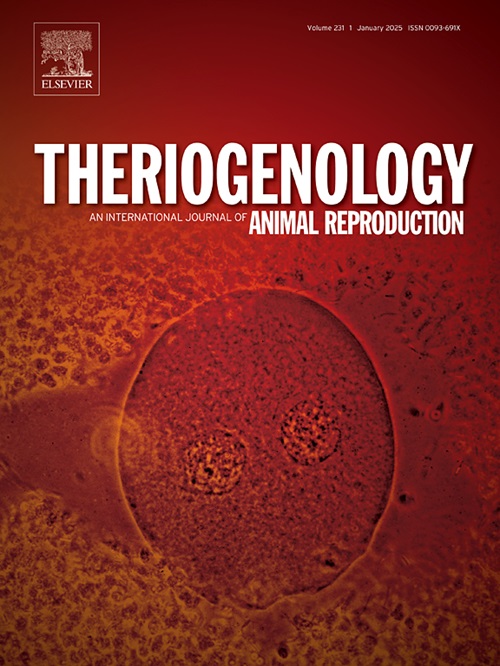Effect of injection conditions on the efficiency of intrafollicular immature oocyte transfer (IFIOT)
IF 2.4
2区 农林科学
Q3 REPRODUCTIVE BIOLOGY
引用次数: 0
Abstract
We investigated whether injection conditions affect the efficiency of intrafollicular immature oocyte transfer (IFIOT). Four types of needles (27G Gingival, 27G WTA, 27G Spinal, and 30G Gingival), two volumes of phosphate-buffered saline (PBS, 10 and 20 μL), and two quantities (25 and 50) of cumulus-oocyte complexes (COCs) were tested using slaughterhouse ovaries. COCs were injected into follicles ≥10 mm and aspirated. Resistance during injection, reflux, and retention of COCs in the system, as well as recovery and denudation rates were evaluated. Based on these in vitro tests, the 27G Spinal needle with 10 μL were selected for in vivo evaluation using 25 (T25) or 50 (T50) COCs. Simultaneously, groups of 25–30 COCs were used for in vitro embryo production (IVP). After 9 days, uterine flushing was performed, and the diameter and cell number of the embryos produced via IFIOT and IVP were determined. The 10-μL volume was then compared with the previously used 60-μL volume. Data were analyzed using analysis of variance. The recovery rates of the structures and embryos were not affected (P > 0.05) by the quantity of COCs or the quality of injection. However, the 60-μL volume resulted in higher recovery rates of structures than did the 10-μL volume (P ≤ 0.05). The IFIOT and IVP embryos showed similar diameters and cell numbers (P > 0.05). We conclude that the 27G Spinal needle with a volume of approximately 60 μL is the most recommended for IFIOT.
注射条件对卵泡内未成熟卵母细胞移植效率的影响
我们研究了注射条件是否会影响卵泡内未成熟卵母细胞转移(IFIOT)的效率。我们使用屠宰场卵巢测试了四种类型的针头(27G Gingival、27G WTA、27G Spinal 和 30G Gingival)、两种体积的磷酸盐缓冲盐水(PBS,10 和 20 μL)以及两种数量(25 和 50)的积珠-卵母细胞复合体(COCs)。将 COC 注入≥10 毫米的卵泡并吸出。对注射过程中的阻力、回流、COC 在系统中的保留以及恢复和去核率进行了评估。根据这些体外测试结果,选择了注射 10 μL COCs 的 27G 脊髓针进行体内评估,使用的是 25 (T25) 或 50 (T50) COCs。同时,25-30 个 COC 被用于体外胚胎生产(IVP)。9 天后,进行子宫冲洗,并测定通过 IFIOT 和 IVP 生产的胚胎的直径和细胞数。然后将 10-μL 容积与之前使用的 60-μL 容积进行比较。数据采用方差分析法进行分析。结构和胚胎的恢复率不受 COC 数量或注射质量的影响(P > 0.05)。不过,60μL 容量的结构复苏率高于 10μL 容量的结构复苏率(P ≤ 0.05)。IFIOT 和 IVP 胚胎显示出相似的直径和细胞数(P > 0.05)。我们的结论是,最推荐使用容积约为 60 μL 的 27G 脊髓针进行 IFIOT。
本文章由计算机程序翻译,如有差异,请以英文原文为准。
求助全文
约1分钟内获得全文
求助全文
来源期刊

Theriogenology
农林科学-生殖生物学
CiteScore
5.50
自引率
14.30%
发文量
387
审稿时长
72 days
期刊介绍:
Theriogenology provides an international forum for researchers, clinicians, and industry professionals in animal reproductive biology. This acclaimed journal publishes articles on a wide range of topics in reproductive and developmental biology, of domestic mammal, avian, and aquatic species as well as wild species which are the object of veterinary care in research or conservation programs.
 求助内容:
求助内容: 应助结果提醒方式:
应助结果提醒方式:


